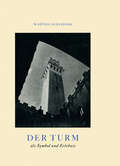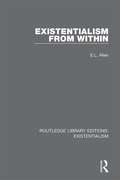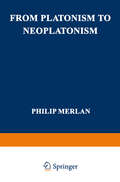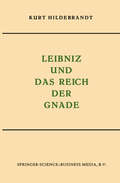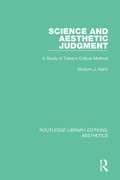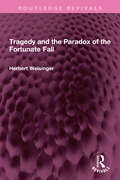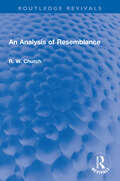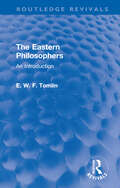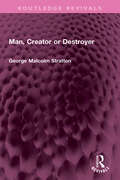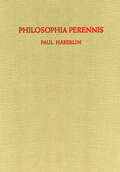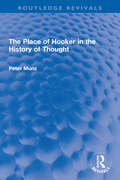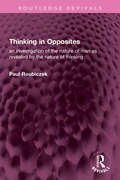- Table View
- List View
Der Turm: als Symbol und Erlebnis
by M. Révész-AlexanderIch habe mir in diesem Buch die Aufgabe gestellt, die Bedeutung, den Sinn und den Ausdrucksgehalt des Turmes zu erforschen. In langjähriger Beschäftigung mit diesem Problem bin ich zu einer Deutung gekommen, die mich immer mehr befriedigte, je mehr und je verschiedenere Türme ich sah und einer Analyse unterwarf. Es war demnach mein Ziel, diese Interpretation, die ausschliesslich für diese einzigartige architektonische Schöpfungen gilt, überzeugend und deutlich darzustellen. Dadurch hoffe ich die wesentlichsten, von Zeit und Stil unabhängigen Merkqlale des Turmes von allen Seiten beleuchtet zu haben. Es ergibt sich daraus von selbst, dass ich weder danach strebte, eine Entwicklungsgeschichte des Turmes zu geben, noch eine vollständige Ty pologie der Türme verschiedener Länder aufzustellen, sondern das Prinzipielle und Wesentliche, das in allen Türmen gemeinsam ist, zu finden und an treffenden Beispielen zu demonstrieren. Amsterdam, Juli 1953. Dr Magda Revcsz-Alexander. Inhaltsverzeichnis Einleitung . 1 Der Turm von Babel 3 Sinn und Funktion des Turmes. 13 Die zwei extremen Erscheinungsformen: der statische und der dynamische Turmtypus . 23 Turm und Gebäude 43 Der Turm im Gesamtbild diesseits und jenseits der Alpen. 59 Warum hat die griechische Baukunst keine Türme? . 73 Der Pharos von Alexandria . 83 Warum had die römische Baukunst keine Türme? 91 Der Turm in unserer Zeit. 103 Schlussbetrachtung 119 Summary . 125 Sachregister 133 Namenregister 135 Bildernachweis Ed. Alinari, Florenz: Abb. 15, 17, 25, 26, 27, 28, 31,33,34; Anderson, Rom: Abb. 10,32; Belgisch Verkeersbureau, Amsterdam: Abb. 21, 24; Bildarchiv, Marburg alL: Abb. 20, 35; Ed. Brogi: Abb.
Existentialism from Within (Routledge Library Editions: Existentialism #4)
by E.L. AllenThis book, first published in 1953, was one of the first written in English that attempted to provide a sympathetic analysis of the new movement of Existentialism. In the attempt to bring out what is of permanent value in what was at the time a study yet to gain academic recognition, it is a valuable work that presents a clear-eyed analysis from the ground up.
Existentialism from Within (Routledge Library Editions: Existentialism #4)
by E.L. AllenThis book, first published in 1953, was one of the first written in English that attempted to provide a sympathetic analysis of the new movement of Existentialism. In the attempt to bring out what is of permanent value in what was at the time a study yet to gain academic recognition, it is a valuable work that presents a clear-eyed analysis from the ground up.
Introduction to French Local Government (Routledge Library Editions: Government)
by Brian ChapmanOriginally published in 1953, this was the first post-War study in either English or French of the institutions and law relating to French local government and on the practice of French local administration. It is a study in political science and therefore, although the basic laws governing local institutions are dealt with in some detail, the aim is to give a picture of those institutions at work in the middle of the 20th Century. The book assumes no prior knowledge of the subject and will be of interest to students of French government and comparative political institutions.
Introduction to French Local Government (Routledge Library Editions: Government)
by Brian ChapmanOriginally published in 1953, this was the first post-War study in either English or French of the institutions and law relating to French local government and on the practice of French local administration. It is a study in political science and therefore, although the basic laws governing local institutions are dealt with in some detail, the aim is to give a picture of those institutions at work in the middle of the 20th Century. The book assumes no prior knowledge of the subject and will be of interest to students of French government and comparative political institutions.
Leibniz und das Reich der Gnade
by Kurt HildebrandtViel, schwerlich zuviel, wird heute von der Kultur, der Bil dungseinheit des Abendlandes gesprochen. Nicht wenige aller dings empfehlen heute, die ganze überschwer gewordene und wenig versprechende Last abzuwerfen. Wenn aber wirklich der Menschheit der Marsch durch die Eiswüste des Nihilismus beschieden wäre, würde sie den ohne hinreichendes Gepäck überstehen? Zwar kann ihr das bloße "Es war einmal" der Geschichte nichts helfen: Nur was von Kräften gegenwärtig ist, kann uns in die Zukunft tragen. Aber wir werden uns der gegenwärtigen Kräfte und des künftigen Sinnes nicht beV~-"Ußt ohne Rückblick auf unsere Vergangenheit. Wir beleben diese, wenn wir ausstoßen, was verjährt und tot ist. Wir Deutschen sind im gegenwärtigen Verfall versucht, unsere gesamte Vergangenheit zu verurteilen, weil sie uns ins Verderben geführt hat - oder Trost darin zu fühlen, was wir an Wissenschaft und Technik, an Kunst und Philosophie, an Dichtung und Religion Unvergängliches beigetragen haben. Aber eins hat sich heute gezeigt: das, was die Welt heute am meisten braucht, haben wir am wenigsten gefunden -das Maaß.
Science and Aesthetic Judgement: A Study in Taine's Critical Method (Routledge Library Editions: Aesthetics)
by Sholom J. KahnFirst published in 1953. This title provides an exposition and discussion on Hippolyte Taine (1828-1893), the leader of the Naturalist movement in French criticism. The book examines his theories and some of his practice, as a critic of literature and art. A more general consideration of the chief issues raised by his central problem is also given, namely the attempt to approach the analysis and judgement of works of art historically, and thus to provide an objective basis of criticism. This title will be of interest to students of art history and philosophy.
Science and Aesthetic Judgement: A Study in Taine's Critical Method (Routledge Library Editions: Aesthetics)
by Sholom J. KahnFirst published in 1953. This title provides an exposition and discussion on Hippolyte Taine (1828-1893), the leader of the Naturalist movement in French criticism. The book examines his theories and some of his practice, as a critic of literature and art. A more general consideration of the chief issues raised by his central problem is also given, namely the attempt to approach the analysis and judgement of works of art historically, and thus to provide an objective basis of criticism. This title will be of interest to students of art history and philosophy.
Tragedy and the Paradox of the Fortunate Fall (Routledge Revivals)
by Herbert WeisingerFirst published in 1953, Tragedy and the Paradox of the Fortunate Fall argues that our response to tragedy is made up of a series of responses: the impact of experience which produces the archetypes of belief; the formation of the archetype of rebirth; the crystallization of the archetype of rebirth in the myth and ritual of the ancient Near East; the transformation of myth and ritual in the religions of the ancient world, including Christianity; the formalization of the archetype of rebirth into the concept of felix culpa, the paradox of the fortunate fall and finally the secular utilization of the paradox of the fortunate fall as the substance out of which tragedy is made. This book will be of interest to students of literature, philosophy and history.
Tragedy and the Paradox of the Fortunate Fall (Routledge Revivals)
by Herbert WeisingerFirst published in 1953, Tragedy and the Paradox of the Fortunate Fall argues that our response to tragedy is made up of a series of responses: the impact of experience which produces the archetypes of belief; the formation of the archetype of rebirth; the crystallization of the archetype of rebirth in the myth and ritual of the ancient Near East; the transformation of myth and ritual in the religions of the ancient world, including Christianity; the formalization of the archetype of rebirth into the concept of felix culpa, the paradox of the fortunate fall and finally the secular utilization of the paradox of the fortunate fall as the substance out of which tragedy is made. This book will be of interest to students of literature, philosophy and history.
An Analysis of Resemblance (Routledge Revivals)
by Ralph W. Church dec'dFirst published in 1952, An Analysis of Resemblance has two-fold aims. The opening chapters seek to present what it is not about. It is not concerned with any sense of resemblance in which that term is used by thinkers generally and widely called Hegelian Idealists. The several subsequent chapters of the work advance an analysis of four senses of resemblance. Two of these four senses would seem to be radical – in the etymological sense of the term. The other two senses are derivative. The concluding chapter advances some considerations as to the bearing of an analysis of resemblance on the matters of universals and taxonomy. Professor Church’s clearly stated ideas will arouse much discussion among students of philosophy. This book helps to round off his studies in this field and is a worthy successor to his earlier works.
An Analysis of Resemblance (Routledge Revivals)
by Ralph W. Church dec'dFirst published in 1952, An Analysis of Resemblance has two-fold aims. The opening chapters seek to present what it is not about. It is not concerned with any sense of resemblance in which that term is used by thinkers generally and widely called Hegelian Idealists. The several subsequent chapters of the work advance an analysis of four senses of resemblance. Two of these four senses would seem to be radical – in the etymological sense of the term. The other two senses are derivative. The concluding chapter advances some considerations as to the bearing of an analysis of resemblance on the matters of universals and taxonomy. Professor Church’s clearly stated ideas will arouse much discussion among students of philosophy. This book helps to round off his studies in this field and is a worthy successor to his earlier works.
The Eastern Philosophers: An Introduction (Routledge Revivals)
by E. W. TomlinFirst published in 1952, The Eastern Philosophers provides a straightforward account of the life and work of the great thinkers of the East and attempts to show, in terms intelligible to the ordinary reader, with what remarkable insistence the greatest of these thinkers dwell upon common themes. It discusses themes like Babylonia and Israel; Zoroaster; Hinduism; the Buddha and Buddhism; the Hindu systems; the Chinese Sages and Mohammed and Islam. The book raises three fundamental questions –what are the basic differences between Eastern and Western thought? What does the Western World owe it to the thought of the East and vice versa? In the third place, to what extent is a rapprochement possible between the two worlds of thought? This book is an essential read for students of Philosophy in general and Eastern Philosophy in particular.
The Eastern Philosophers: An Introduction (Routledge Revivals)
by E. W. TomlinFirst published in 1952, The Eastern Philosophers provides a straightforward account of the life and work of the great thinkers of the East and attempts to show, in terms intelligible to the ordinary reader, with what remarkable insistence the greatest of these thinkers dwell upon common themes. It discusses themes like Babylonia and Israel; Zoroaster; Hinduism; the Buddha and Buddhism; the Hindu systems; the Chinese Sages and Mohammed and Islam. The book raises three fundamental questions –what are the basic differences between Eastern and Western thought? What does the Western World owe it to the thought of the East and vice versa? In the third place, to what extent is a rapprochement possible between the two worlds of thought? This book is an essential read for students of Philosophy in general and Eastern Philosophy in particular.
Man, Creator or Destroyer (Routledge Revivals)
by George Malcolm StrattonFirst published in 1952, Man, Creator or Destroyer makes clear that mankind is preeminent both as a creator and as a destroyer. And we are doomed unless creative man can master destructive man. But how gain this mystery? How strengthen the one and weaken the other? This and other vital questions are answered clearly for the general reader interested in creative work, from art and science to crime-prevention and international statecraft. The first part is concerned with man’s creative power which distinguishes him from all else on earth and suggests that man is much more than a machine or an animal. In the second part attention moves to man’s destructive power and studies his inclination to obstruct and shatter his own constructive work. The book concludes with an examination of the ways in which the creative power can gain the mastery.
Man, Creator or Destroyer (Routledge Revivals)
by George Malcolm StrattonFirst published in 1952, Man, Creator or Destroyer makes clear that mankind is preeminent both as a creator and as a destroyer. And we are doomed unless creative man can master destructive man. But how gain this mystery? How strengthen the one and weaken the other? This and other vital questions are answered clearly for the general reader interested in creative work, from art and science to crime-prevention and international statecraft. The first part is concerned with man’s creative power which distinguishes him from all else on earth and suggests that man is much more than a machine or an animal. In the second part attention moves to man’s destructive power and studies his inclination to obstruct and shatter his own constructive work. The book concludes with an examination of the ways in which the creative power can gain the mastery.
The Place of Hooker in the History of Thought (Routledge Revivals)
by Peter MunzFirst Published in 1952, The Place of Hooker in the History of Thought unravels the historical background to some of Richard Hooker’s leading ideas. The volume throws light on his ideas by a clear appreciation of the philosophical issues he raised and the difficulties he had to face when he embraced the cause of Thomism in Elizabethan England. Peter Munz discusses themes like Hooker’s debt to St. Thomas, Hooker and Marsilius of Padua, Hooker’s historical sense, Hooker and Aristotle and Plato, Hooker and Locke, to determine his place in the history of thought. This book will be of interest to scholars and researchers of Philosophy, Religion, Theology, Political Thought and Political Philosophy.
The Place of Hooker in the History of Thought (Routledge Revivals)
by Peter MunzFirst Published in 1952, The Place of Hooker in the History of Thought unravels the historical background to some of Richard Hooker’s leading ideas. The volume throws light on his ideas by a clear appreciation of the philosophical issues he raised and the difficulties he had to face when he embraced the cause of Thomism in Elizabethan England. Peter Munz discusses themes like Hooker’s debt to St. Thomas, Hooker and Marsilius of Padua, Hooker’s historical sense, Hooker and Aristotle and Plato, Hooker and Locke, to determine his place in the history of thought. This book will be of interest to scholars and researchers of Philosophy, Religion, Theology, Political Thought and Political Philosophy.
Routledge Revivals: A Modern Elementary Logic (Routledge Revivals)
by L. Susan StebbingFirst published in 1943, and revised for this 1952 edition, this book was intended for use by students of philosophy and as such traditional and modern developments in logic have been combined in a unified treatment. The author envisaged this volume as filling a gap for a simple, introductory text on formal logic, written from a modern point of view, unencumbered by traditional doctrine. This title provides a thorough introduction and grounding in the philosophy of logic, and was later revised after the author’s death to correct a number of logical errors — making this edition the most complete version of the work.
Routledge Revivals: A Modern Elementary Logic (Routledge Revivals)
by L. Susan StebbingFirst published in 1943, and revised for this 1952 edition, this book was intended for use by students of philosophy and as such traditional and modern developments in logic have been combined in a unified treatment. The author envisaged this volume as filling a gap for a simple, introductory text on formal logic, written from a modern point of view, unencumbered by traditional doctrine. This title provides a thorough introduction and grounding in the philosophy of logic, and was later revised after the author’s death to correct a number of logical errors — making this edition the most complete version of the work.
The Scientific Work of René Descartes: 1596-1650 (Routledge Library Editions: Rene Descartes)
by J. F. ScottWhen originally published in 1952, this book filled a gap in the history of philosophy and science and remains an important work today, because it puts the main mathematical and physical discoveries of Descartes in an accessible form, for the benefit of English readers. Descartes is acknowledged to be the founder of modern mathematics, through his invention of analytical geometry and this volume charts Descartes’ role in bringing a unity into algebra and geometry and the development of mathematics into a discipline which could be properly analysed. Carefully paraphrasing the Géométrie, this volume retains much of Descartes’ original notation as well as the original diagrams. The volume also discusses the considerable contribution that Descartes made to the physical sciences which involved accurate work in optics, light, sight and colour.
The Scientific Work of René Descartes: 1596-1650 (Routledge Library Editions: Rene Descartes)
by J. F. ScottWhen originally published in 1952, this book filled a gap in the history of philosophy and science and remains an important work today, because it puts the main mathematical and physical discoveries of Descartes in an accessible form, for the benefit of English readers. Descartes is acknowledged to be the founder of modern mathematics, through his invention of analytical geometry and this volume charts Descartes’ role in bringing a unity into algebra and geometry and the development of mathematics into a discipline which could be properly analysed. Carefully paraphrasing the Géométrie, this volume retains much of Descartes’ original notation as well as the original diagrams. The volume also discusses the considerable contribution that Descartes made to the physical sciences which involved accurate work in optics, light, sight and colour.
Thinking in Opposites: an investigation of the nature of man as revealed by the nature of thinking (Routledge Revivals)
by Paul RoubiczekFirst published in 1952, Thinking in Opposites insists on the need for a carefully thought-out, rather than a merely authoritarian, basis for faith; but also insists that an indispensable preliminary is to know the laws which govern and limit the scope of human thinking in relation to three areas: the external world as it is; the internal world of feeling; and the interrelation of each of these with the other. This book is not a technical work in philosophy and the theory of knowledge; but it deals with problems in those fields which have usually been handled only in technical language. Therefore, this is a book both for the expert and for the intelligent and thoughtful layman: for the man who has a sense of responsibility for what he believes, and who is able to justify his faith amid the chaos of our times.
